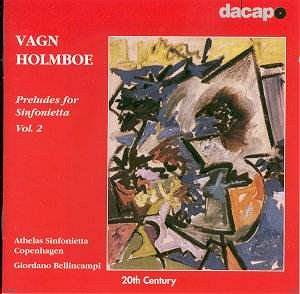At last the second volume arrives. The first volume
is reviewed elsewhere
on this site.
The ten Sinfoniettas, completed between 1986 and 1971,
are late works from Holmboe's pen. He seems to have scaled down his
expression in his wintry years though he was never a composer of obstreperously
over-generous length or texture. The Sinfoniettas are for chamber orchestra
and are dedicated to the great music critic Robert Layton. These gem-brilliant
miniatures recall the busy diamond clarity of Martinu (try To a Pine
Tree) in neo-classical mood though there is no drought of emotional
'juice'.
Interestingly To the calm sea is not the static
reflection I expected. The flickering light and movement suggest a vision
piercing the calm surface and taking in the swirling activity of plankton,
wrack and fish shoals. The buzz of movement also typefies the Seagull
and Cormorant work. The storm clouds enfold the scene in To the
Pollution of Nature. This writing catches vernal freshness and chlorophyll
but hints at the decay induced by air and waterborne chemicals.
These miniatures are not overblown or garrulous. If
anything they exemplify economy of expression. They stand in the line
of perfection achieved by Bonsai cultures. Indeed the music sometimes
veers into the chinoiserie of fellow Scandinavian Fernstrom.
To fill out the disc we get two works with prominent
roles for brass instruments. A string pianist, unblinkingly recorded,
is called for and is provided. In the case of the Music with Horn
this work would make a good partner for the Brahms, Holbrooke or
Berkeley Horn Trios. The Trombone work allows for a cantorial role and
the instrument is very much the singer not the clown. Once again I note
spiritual parallels with Alan Hovhaness. The Horn work is the oldest
on the disc and is also the most fractured with tribute to the tone-prickly
Epitaphs rather than to the singing neo-classicism of the Preludes.
This is another invaluable gain to the Holmboe discography.
We certainly now need to have the Nietzsche Requiem. Although
there has, for several years, been talk of such a recording nothing
has so far transpired.
Rob Barnett

![]() Jesper Juul Sørensen
(trombone)
Jesper Juul Sørensen
(trombone) ![]() DACAPO 8.224124 [50.43]
DACAPO 8.224124 [50.43]